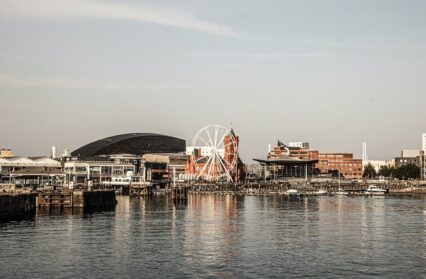In the latest article collaboration between Wales Arts Review and the Western Mail, Emma Schofield looks at what can be learned of our cities from two contemporary Welsh novels.
 If ever there were a case of an area facing an identity crisis, late 1990’s South Wales seems to have fitted the bill perfectly. With the country divided politically in the wake of a devolution referendum in which the people of Wales had voted for a Welsh Assembly by a margin of less than one percent, South Wales was still struggling to recover from the industrial decline which had scarred the area throughout the 1970s and 80s. By the close of the millennium, this once industrial area had undergone major changes with the redevelopment of the former docklands in Cardiff leading to the creation of Cardiff Bay and the future home of the new Welsh Assembly. Yet while Cardiff underwent significant change, other areas struggled to keep apace of the changes underway in the wake of the referendum. With this rapid change in mind, Erica Wooff’s 2002 novel Mud Puppy and Trezza Azzopardi’s 2001 autobiographical novel, The Hiding Place, present urban landscapes and a connection to an industrial past as an integral to their characters’ sense of identity. Both novels feature protagonists who move away from their respective hometowns to pursue opportunities outside of Wales, before returning to their childhood homes as adult women.
If ever there were a case of an area facing an identity crisis, late 1990’s South Wales seems to have fitted the bill perfectly. With the country divided politically in the wake of a devolution referendum in which the people of Wales had voted for a Welsh Assembly by a margin of less than one percent, South Wales was still struggling to recover from the industrial decline which had scarred the area throughout the 1970s and 80s. By the close of the millennium, this once industrial area had undergone major changes with the redevelopment of the former docklands in Cardiff leading to the creation of Cardiff Bay and the future home of the new Welsh Assembly. Yet while Cardiff underwent significant change, other areas struggled to keep apace of the changes underway in the wake of the referendum. With this rapid change in mind, Erica Wooff’s 2002 novel Mud Puppy and Trezza Azzopardi’s 2001 autobiographical novel, The Hiding Place, present urban landscapes and a connection to an industrial past as an integral to their characters’ sense of identity. Both novels feature protagonists who move away from their respective hometowns to pursue opportunities outside of Wales, before returning to their childhood homes as adult women.
As homecomings go, Daryl’s return to Newport in Mud Puppy is far from dramatic or triumphant. The novel opens with struggling artist Daryl making the journey back to her hometown of Newport after nine years of away, working in London. Daryl arrives via Newport train station, gazing out of the window as the train crosses the bridge into the city and observing the mud filled banks of the tidal river Usk beneath her. Interestingly, the muddy estuary is the feature Daryl appears to associate most keenly with a sense of homecoming. She goes on to confess that when she first left Newport for London she pined for the muddy banks of the river Usk, leading to her excitement on trips back to the city:
“when the train finally pulled across the bridge I would pull and press down the door-window catch and hang my head out to feel the wind pinching my cheeks. I would close my eyes against the skewering rain and breathe in great big gasps of mud. The sweet-salt-sulphur stink of it.”
… to read the rest of this article, subscribe to the new Wales Arts Review substack.












